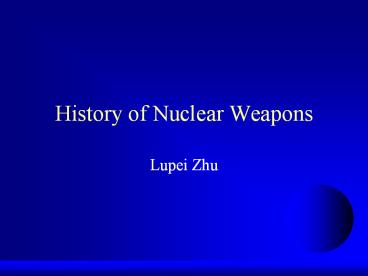History of Nuclear Weapons PowerPoint PPT Presentation
Title: History of Nuclear Weapons
1
History of Nuclear Weapons
- Lupei Zhu
2
Topics
- Important discoveries before WWII that led to
nuclear weapons. - The Manhattan Project.
- Nuclear weapon attacks on Japan in WWII.
- Current states with nuclear weapons.
3
Important discoveries pre-WWII
- By the end of 19th century, people knew the all
matter is made of basic substances called
elements. Each element consists of a particular
type of particle atom. But they believed that
atom is the smallest particle that can not be
divided further. - In 1896 French physicist Antoine Henri
Becquerel's experiments led to the discovery of
radioactivity atomic nucleus of certain elements
emit energetic particles (rays). He shared the
1903 Nobel Prize with Pierre and Marie Curie.
4
Important discoveries pre-WWII
- In 1899 Ernest Rutherford discovered two kinds
of rays emitting from radium. The first is
positively charged and he called alpha rays
(turned out late to be the helium nucleus, which
consists of two protons and two neutrons) the
more penetrating negative charged rays he called
beta rays (electrons). - The third one, the gamma ray, has no charge and
late found to be photon (light).
5
Important discoveries pre-WWII
- In June, 1919, Rutherford bombarded nitrogen gas
with alpha particles and obtained atoms of an
oxygen isotope and protons. This transmutation of
nitrogen into oxygen is the first artificially
induced nuclear reaction 7N a 8O
p
6
Important discoveries pre-WWII
- 1932 February - James Chadwick discovered the
neutron. It has the same mass as proton but
without charge. - 1934 Frédéric and Irène Joliot-Curie discovered
artificial radioactivity. Enrico Fermi irradiated
uranium with neutrons, unknowingly achieved the
world's first nuclear fission. - 1938-1939 - Otto Hahn sent a paper to Lise
Meitner containing experimental results that were
interpreted by Meitner and nephew Otto Frisch as
nuclear fission.
7
Manhattan Project
- As World War II broke out it became clear that
the Germans understood fission as well and were
interested in making a bomb. - At the urging of prominent scientists, including
Albert Einstein, the US government was persuaded
to start a program to develop weapons. - American scientists were skeptic of fission
however and didnt start a concentrated effort
until Dec. 6, 1941. - By August 1942 things had gotten serious and the
Manhattan Project was officially born.
8
Manhattan Project Movie (6m)
9
4 Components in the Project
- Achieve a chain reaction/ produce plutonium. This
was carried out at the University of Chicago,
called the Met Lab, and led by Compton and Fermi. - Mass production of U235, the fissionable isotope
of uranium, carried out at the Oak Ridge
Laboratories in Tennessee. - Mass production of plutonium, a better
fissionable material than U235, carried out at
Hanford, Washington. - Design and testing of actual nuclear bombs. This
was carried out at Los Alamos, New Mexico under
the direction of Oppenheimer.
10
Testing in Manhattan Project
- By the July of 1945 enough fissionable material
had been developed (and the bomb design had
advanced enough) that a test was planned. - Everyone was confident the U235 bomb would work,
but the plutonium bomb was a different story - so
it needed a test. - On July 4th a test shot of 100 tons of high
explosive was done. The explosive was purposely
contaminated with radioactive elements so that
scientists could track the contamination. - On July 16, the real test was performed and was
actually bigger than expected (21 kt). It was
code-named Trinity.
11
Use of atomic bombs in WII
- The first atomic bomb, Little Boy, was dropped in
Hiroshima on Aug. 6, 1945. The yield is 15 kt.
70,000 people killed. - Three days later, the 2nd bomb, the Fat Man, was
dropped in Nakasaki with a yield of 20 kt. 52,000
people died.
12
Use of atomic bombs in WII
13
States with nuclear weapons
- NPT-Recognized
- US (1945)
- Russia (1949)
- UK (1952)
- France (1960)
- China (1964)
De facto India (1974) Pakistan (1998) N.
Korea (2006). Unacknowledged Israel. Abandoned
S. Africa Belarus Kazakhstan Ukraine. In
Progress Iran

